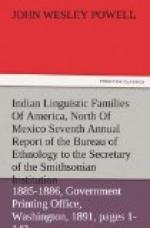The Chimakum are said to have been formerly one of the largest and most powerful tribes of Puget Sound. Their warlike habits early tended to dimmish their numbers, and when visited by Gibbs in 1854 they counted only about seventy individuals. This small remnant occupied some fifteen small lodges on Port Townsend Bay. According to Gibbs “their territory seems to have embraced the shore from Port Townsend to Port Ludlow."[31] In 1884 there were, according to Mr. Myron Eells, about twenty individuals left, most of whom are living near Port Townsend, Washington. Three or four live upon the Skokomish Reservation at the southern end of Hood’s Canal.
[Footnote 31: Dr. Boas
was informed in 1889, by a surviving Chimakum
woman and several Clallam,
that the tribe was confined to the
peninsula between Hood’s
Canal and Port Townsend.]
The Quile-ute, of whom in 1889 there were 252 living on the Pacific south of Cape Flattery, belong to the family. The Hoh, a sub-tribe of the latter, number 71 and are under the Puyallup Agency.
PRINCIPAL TRIBES.
The following tribes are recognized:
Chimakum.
Quile-ute.
CHIMARIKAN FAMILY.
= Chim-a-ri’-ko, Powell in Cont.
N.A. Eth., III, 474, 1877. Gatschet
in Mag. Am. Hist., 255, April,
1882 (stated to be a distinct family).
According to Powers, this family was represented, so far as known, by two tribes in California, one the Chi-mal-a-kwe, living on New River, a branch of the Trinity, the other the Chimariko, residing upon the Trinity itself from Burnt Ranch up to the mouth of North Fork, California. The two tribes are said to have been as numerous formerly as the Hupa, by whom they were overcome and nearly exterminated. Upon the arrival of the Americans only twenty-five of the Chimalakwe were left. In 1875 Powers collected a Chimariko vocabulary of about two hundred words from a woman, supposed to be one of the last three women of that tribe. In 1889 Mr. Curtin, while in Hoopa Valley, found a Chimariko man seventy or more years old, who is believed to be one of the two living survivors of the tribe. Mr. Curtin obtained a good vocabulary and much valuable information relative to the former habitat and history of the tribe. Although a study of these vocabularies reveals a number of words having correspondences with the Kulanapan (Pomo) equivalents, yet the greater number show no affinities with the dialects of the latter family, or indeed with any other. The family is therefore classed as distinct.
PRINCIPAL TRIBES.
Chimariko.
Chimalakwe.
CHIMMESYAN FAMILY.
= Chimmesyan, Latham in Jour. Eth.
Soc. Lond., I, 154, 1848 (between
53 deg. 30’ and 55 deg. 30’
N.L.). Latham, Opuscula, 250, 1860.




